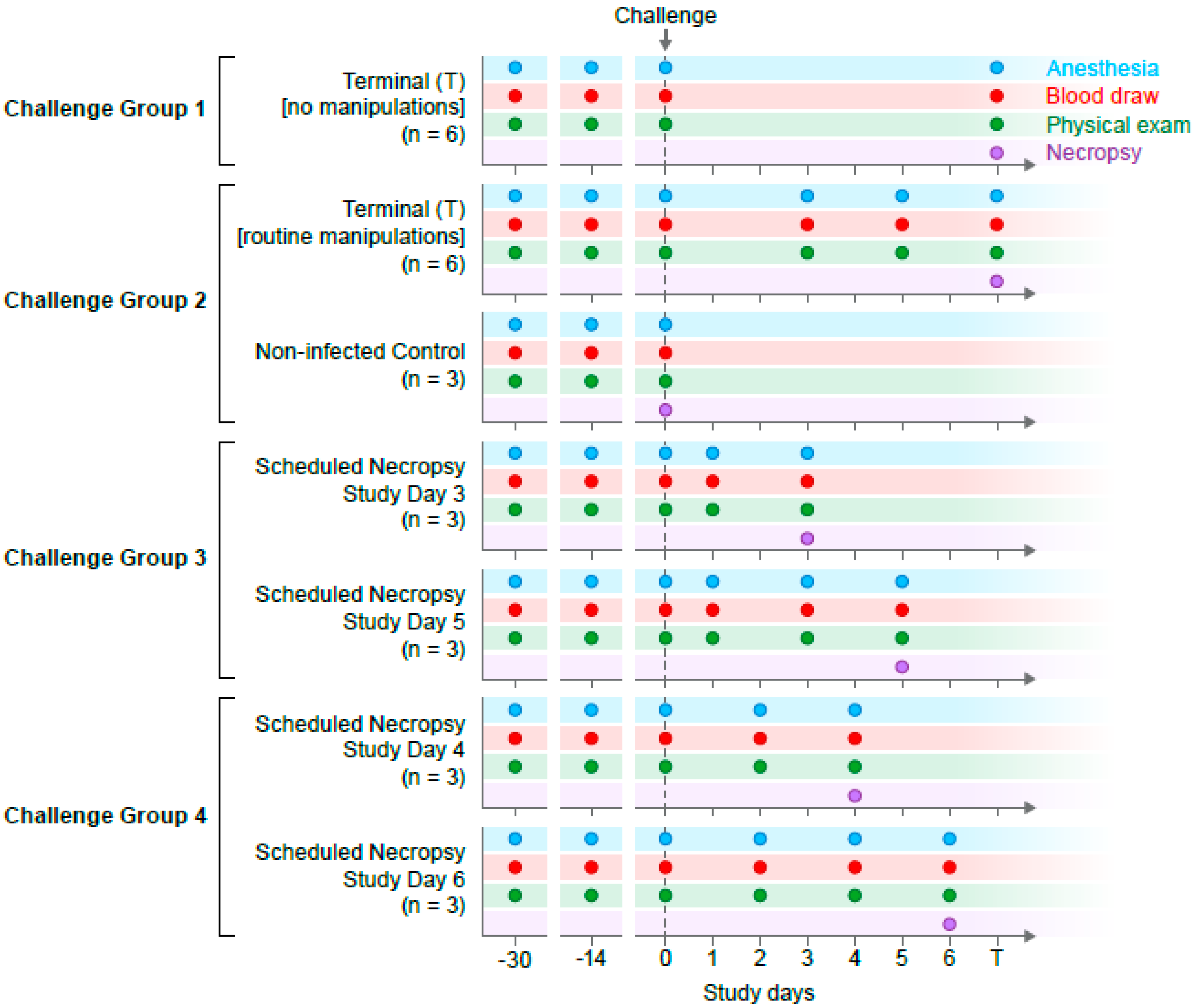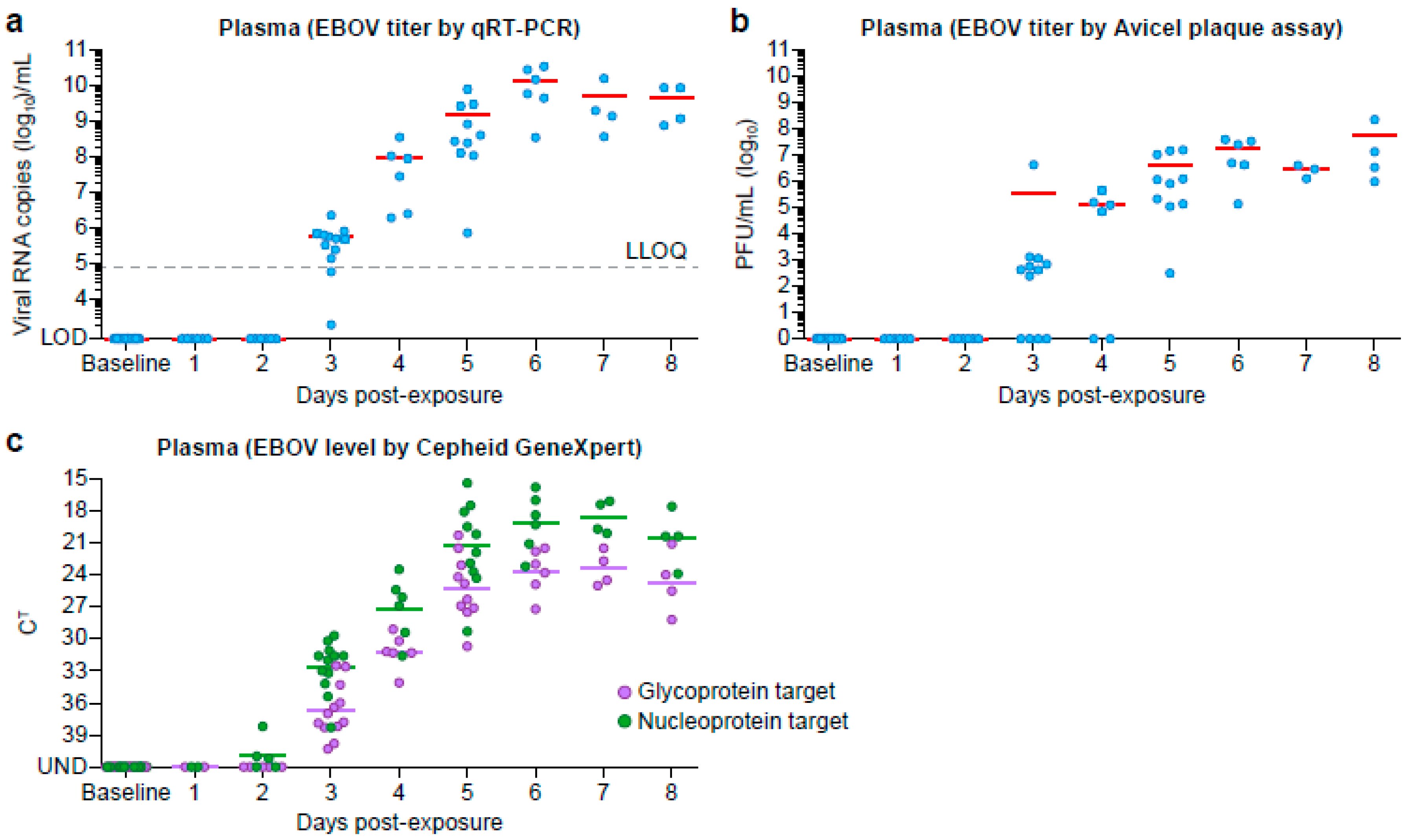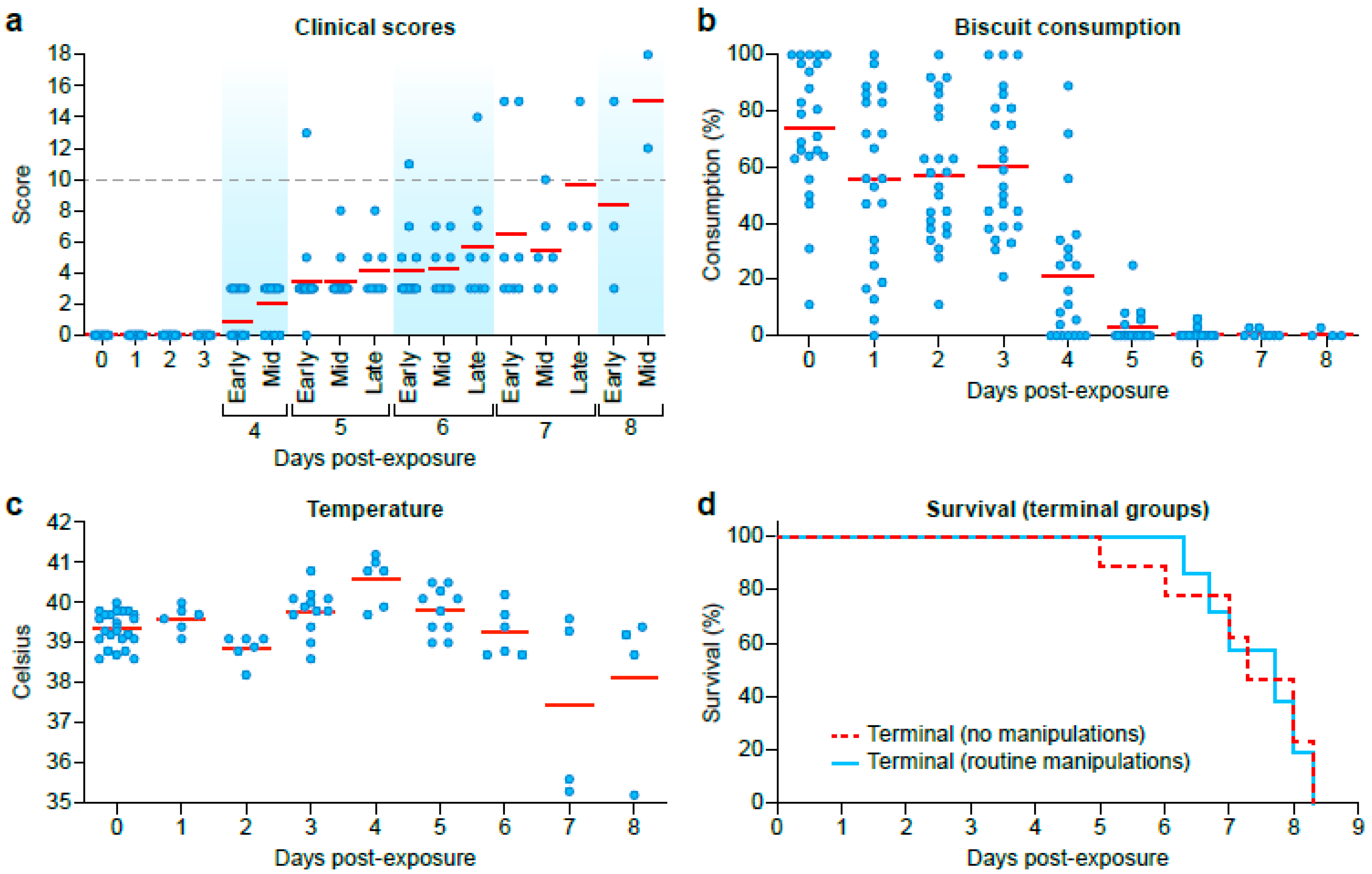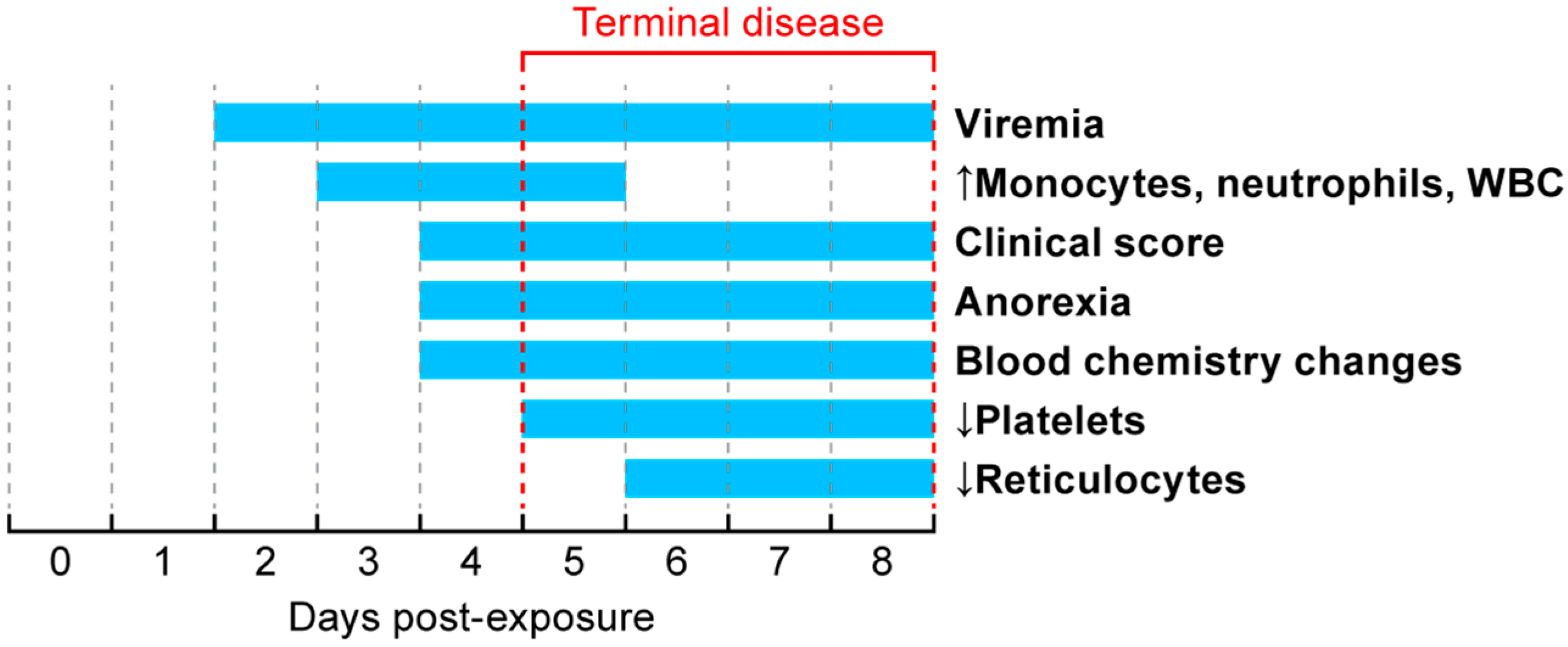Kikwit Ebola Virus Disease Progression in the Rhesus Monkey Animal Model
Abstract
1. Introduction
2. Materials and Methods
2.1. Virus
2.2. Animals
2.3. Animal Ethics’ Disclosure
2.4. Reverse-Transcriptase Quantitative Real-Time PCR (RT-qPCR)
2.5. GeneXpert
2.6. Plaque Assay
2.7. Tissue Processing
2.8. Serum Processing
2.9. Hematology
2.10. Semen Collection
2.11. Clinical Observations, Euthanasia Criteria, and Necropsy
2.12. Statistical Methods
3. Results
3.1. Virus Inoculum, Viremia, and Virus Detection in the Oral Cavity
3.2. Clinical Observations, Scoring, and Survival
3.3. Serum Chemistry
3.4. Hematology
3.5. EBOV Detection in Semen
4. Discussion
Supplementary Materials
Author Contributions
Funding
Acknowledgments
Conflicts of Interest
References
- Kuhn, J.H.; Amarasinghe, G.K.; Perry, D.L. Filoviridae. In Fields Virology, 7th ed.; Howley, P.M., Knipe, D.M., Whelan, S.P.J., Eds.; Wolters Lluwer/Lippincott Williams & Wilkins: Philadelphia, PA, USA, 2020; pp. 449–503. [Google Scholar]
- Bray, M.; Davis, K.; Geisbert, T.; Schmaljohn, C.; Huggins, J. A mouse model for evaluation of prophylaxis and therapy of Ebola hemorrhagic fever. J. Infect. Dis. 1998, 178, 651–661. [Google Scholar] [CrossRef] [PubMed]
- Chan, M.; Leung, A.; Griffin, B.D.; Vandramelli, R.; Tailor, N.; Tierney, K.; Audet, J.; Kobasa, D. Generation and Characterization of a Mouse-Adapted Makona Variant of Ebola Virus. Viruses 2019, 11, 987. [Google Scholar] [CrossRef] [PubMed]
- Gibb, T.R.; Bray, M.; Geisbert, T.W.; Steele, K.E.; Kell, W.M.; Davis, K.J.; Jaax, N.K. Pathogenesis of experimental Ebola Zaire virus infection in BALB/c mice. J. Comp. Pathol. 2001, 125, 233–242. [Google Scholar] [CrossRef] [PubMed]
- Haddock, E.; Feldmann, H.; Marzi, A. Ebola Virus Infection in Commonly Used Laboratory Mouse Strains. J. Infect. Dis. 2018, 218, s453–s457. [Google Scholar] [CrossRef] [PubMed]
- Bray, M.; Hatfill, S.; Hensley, L.; Huggins, J.W. Haematological, biochemical and coagulation changes in mice, guinea-pigs and monkeys infected with a mouse-adapted variant of Ebola Zaire virus. J. Comp. Pathol. 2001, 125, 243–253. [Google Scholar] [CrossRef] [PubMed]
- Connolly, B.M.; Steele, K.E.; Davis, K.J.; Geisbert, T.W.; Kell, W.M.; Jaax, N.K.; Jahrling, P.B. Pathogenesis of experimental Ebola virus infection in guinea pigs. J. Infect. Dis. 1999, 179, s203–s217. [Google Scholar] [CrossRef] [PubMed]
- Twenhafel, N.A.; Shaia, C.I.; Bunton, T.E.; Shamblin, J.D.; Wollen, S.E.; Pitt, L.M.; Sizemore, D.R.; Ogg, M.M.; Johnson, S.C. Experimental aerosolized guinea pig-adapted Zaire ebolavirus (variant: Mayinga) causes lethal pneumonia in guinea pigs. Vet. Pathol. 2015, 52, 21–25. [Google Scholar] [CrossRef]
- Wong, G.; Qiu, X.; Richardson, J.S.; Cutts, T.; Collignon, B.; Gren, J.; Aviles, J.; Embury-Hyatt, C.; Kobinger, G.P. Ebola virus transmission in guinea pigs. J. Virol. 2015, 89, 1314–1323. [Google Scholar] [CrossRef]
- Bird, B.H.; Spengler, J.R.; Chakrabati, A.K.; Khristova, M.L.; Sealy, T.K.; Coleman-McCray, J.D.; Martin, B.E.; Dodd, K.A.; Goldsmith, C.S.; Sanders, J. Humanized Mouse Model of Ebola Virus Disease Mimics the Immune Responses in Human Disease. J. Infect. Dis. 2016, 213, 703–711. [Google Scholar] [CrossRef]
- Escudero-Perez, B.; Ruibal, P.; Rottstegge, M.; Lüdtke, A.; Port, J.R.; Hartmann, K.; Gómez-Medina, S.; Müller-Guhl, J.; Nelson, E.V.; Krasemann, S.; et al. Comparative pathogenesis of Ebola virus and Reston virus infection in humanized mice. JCI Insight 2019, 4, 21. [Google Scholar] [CrossRef]
- Cross, R.W.; Mire, C.E.; Borisevich, V.; Geisbert, J.B.; Fenton, K.A.; Geisbert, T.W. The Domestic Ferret (Mustela putorius furo) as a Lethal Infection Model. for 3 Species of Ebolavirus. J. Infect. Dis. 2016, 214, 565–569. [Google Scholar] [CrossRef] [PubMed]
- De La Vega, M.A.; Soule, G.; Tran, K.N.; Tierney, K.; He, S.; Wong, G.; Qiu, X.; Kobinger, G.P. Modeling Ebola Virus Transmission Using Ferrets. Msphere 2018, 3, 5. [Google Scholar] [CrossRef]
- Wong, G.; Leung, A.; He, S.; Cao, W.; De La Vega, M.A.; Griffin, B.D.; Soule, G.; Kobinger, G.P.; Kobasa, D.; Qiu, W. The Makona Variant of Ebola Virus Is Highly Lethal to Immunocompromised Mice and Immunocompetent Ferrets. J. Infect. Dis. 2018, 218, s466–s470. [Google Scholar] [CrossRef] [PubMed]
- Bowen, E.T.; Platt, G.S.; Simpson, D.I.H.; McArdell, L.B.; Raymond, R.T. Ebola haemorrhagic fever: Experimental infection of monkeys. Trans. R. Soc. Trop. Med. Hyg. 1978, 72, 188–191. [Google Scholar] [CrossRef]
- Ebihara, H.; Rockx, B.; Marzi, A.; Feldmann, F.; Haddock, E.; Brinning, D.; LaCasse, R.A.; Gardner, D.; Feldmann, H. Host response dynamics following lethal infection of rhesus macaques with Zaire ebolavirus. J. Infect. Dis. 2011, 204, s991–s999. [Google Scholar] [CrossRef]
- Geisbert, T.W.; Hensley, L.E.; Larsen, T.; Young, H.A.; Reed, D.S.; Geisbert, J.B.; Scott, D.P.; Kagan, E.; Jahrling, P.B.; Davis, K.J. Pathogenesis of Ebola hemorrhagic fever in cynomolgus macaques: Evidence that dendritic cells are early and sustained targets of infection. Am. J. Pathol. 2003, 163, 2347–2370. [Google Scholar] [CrossRef]
- Geisbert, T.W.; Pushko, P.; Anderson, K.; Smith, J.; Davis, K.J.; Jahrling, P.B. Evaluation in nonhuman primates of vaccines against Ebola virus. Emerg. Infect. Dis. 2002, 8, 503–507. [Google Scholar] [CrossRef]
- Honko, A.N.; Johnson, J.C.; Marchand, J.S.; Huzella, L.; Adams, R.D.; Oberlander, N.; Tozewski, L.M.; Bennet, R.S.; Hensley, L.E.; Jahrling, P.B.; et al. High. dose sertraline monotherapy fails to protect rhesus macaques from lethal challenge with Ebola virus Makona. Sci. Rep. 2017, 7, 5886. [Google Scholar]
- Pettitt, J.; Higgs, E.; Fallah, M.; Nason, M.; Stavale, E.; Marchand, J.; Reilly, C.; Jensen, K.; Dighero-Kemp, B.; Tuznik, K.; et al. Assessment and Optimization of the GeneXpert Diagnostic Platform for Detection of Ebola Virus RNA in Seminal Fluid. J. Infect. Dis. 2017, 215, 547–553. [Google Scholar] [CrossRef]
- Wong, G.; Qiu, X.; De La Vega, M.A.; Fernando, L.; Wei, H.; Bello, A.; Fausther-Bovendo, H.; Audet, J.; Kroeker, A.; Kozak, R.; et al. Pathogenicity Comparison Between the Kikwit and Makona Ebola Virus Variants in Rhesus Macaques. J. Infect. Dis. 2016, 214, s281–s289. [Google Scholar] [CrossRef]
- Marzi, A.; Feldmann, F.; Hanley, P.W.; Scott, D.P.; Günther, S.; Feldmann, H. Delayed Disease Progression in Cynomolgus Macaques Infected with Ebola Virus Makona Strain. Emerg. Infect. Dis. 2015, 21, 1777–1783. [Google Scholar] [CrossRef] [PubMed]
- Warren, T.; Zumbrun, E.; Weidner, J.M.; Gomba, L.; Rossi, F.; Bannister, R.; Tarrant, J.; Reed, M.; Lee, E.; Raymond, J.L. Characterization of Ebola Virus Disease (EVD) in Rhesus Monkeys for Development of EVD Therapeutics. Viruses 2020, 12, 92. [Google Scholar] [CrossRef] [PubMed]




| Parameter (Units) | Study Day (Number of Animals) | p Value a | ||||||||||
|---|---|---|---|---|---|---|---|---|---|---|---|---|
| BL1 (27) | BL2 (27) | 1 (6) | 2 (6) | 3 (11) | 4 (6) | 5 (10) | 6 (6) | 7 (4) | 8 (4) | |||
| ALT (U/L) | Avg | 36.2 | 35.5 | 47.2 | 44.7 | 43.2 | 42.0 | 189.1 | 295.2 | 508.0 | 370.3 | 0.260 |
| SD | 9.5 | 10.8 | 10.8 | 12.9 | 12.3 | 10.3 | 183.5 | 200.4 | 437.6 | 228.3 | ||
| ALB (g/dL) | Avg | 3.5 | 3.4 | 3.4 | 3.4 | 3.3 | 3.4 | 2.6 | 2.4 | 1.9 | 2.2 | 0.078 |
| SD | 0.3 | 0.3 | 0.2 | 0.2 | 0.4 | 0.2 | 0.4 | 0.4 | 0.2 | 0.1 | ||
| ALB:GLOB (ratio) | Avg | 0.99 | 1.03 | 0.96 | 0.92 | 1.01 | 0.89 | 0.72 | 0.62 | 0.54 | 0.57 | 0.092 |
| SD | 0.12 | 0.12 | 0.08 | 0.11 | 0.22 | 0.11 | 0.16 | 0.14 | 0.06 | 0.03 | ||
| ALP (U/L) | Avg | 164.1 | 151.4 | 142.2 | 147.0 | 165.6 | 168.3 | 299.1 | 600.2 | 1074.3 | 853.8 | 0.900 |
| SD | 83.0 | 69.6 | 39.2 | 59.3 | 60.2 | 49.6 | 130.8 | 262.7 | 484.5 | 482.5 | ||
| AMY (U/L) | Avg | 397 | 385.8 | 405.7 | 394.2 | 336.9 | 323.3 | 225.1 | 382.8 | 395.5 | 373.5 | 0.743 |
| SD | 129.7 | 138.6 | 121.7 | 55.7 | 78 | 66.6 | 72.0 | 194.7 | 186.6 | 197.0 | ||
| AST (U/L) | Avg | 35.8 | 34.2 | 65.3 | 36.5 | 43.4 | 49.0 | 478.0 | 844.3 | 747.3b | 1221.5 | 0.972 |
| SD | 6.0 | 5.8 | 18.4 | 5.7 | 18.4 | 13.1 | 462.8 | 427.3 | 64.6 | 506.2 | ||
| BUN (mg/dL) | Avg | 18.41 | 19.22 | 16.8 | 17.0 | 16.5 | 15.8 | 22.7 | 29.7 | 117.8 | 74.7b | 0.352 |
| SD | 3.56 | 4.04 | 3.6 | 2.4 | 3.9 | 1.5 | 25.4 | 9.4 | 66.6 | 59.8 | ||
| BUN:CREc (ratio) | Avg | 22.3 | 23.8 | 30.1 | 26.5 | 20.2 | 15.8 | 12.3 | 15.3 | 9.1 | 18.2 | 0.944 |
| SD | 5.8 | 4.8 | 5.9 | 5.0 | 5.2 | 2.2 | 3.9 | 6.0 | 9.1 | 2.2 | ||
| CAL (mg/dL) | Avg | 9.5 | 9.4 | 9.8 | 9.8 | 9.2 | 9.2 | 8.2 | 7.7 | 6.0 | 8.1 | 0.258 |
| SD | 0.4 | 0.3 | 0.2 | 0.3 | 0.4 | 0.3 | 0.6 | 0.5 | 1.3 | 0.4 | ||
| CRE (mg/dL) | Avg | 0.85 | 0.81 | 0.57 | 0.65 | 0.83 | 1.02 | 1.63 | 2.27 | 7.28 | 3.6 | 0.772 |
| SD | 0.13 | 0.11 | 0.09 | 0.05 | 0.14 | 0.13 | 1.27 | 1.43 | 4.68 | 2.86 | ||
| GGT (U/L) | Avg | 65.9 | 61.9 | 62.5 | 69.0 | 64.4 | 64.7 | 97.9 | 159.7 | 277.3 | 221.8 | 0.978 |
| SD | 21.0 | 20.7 | 16.9 | 18.4 | 12.8 | 11.4 | 73.2 | 56.9 | 81.3 | 63.9 | ||
| GLOB (g/dL) | Avg | 3.60 | 3.36 | 3.62 | 3.75 | 3.34 | 3.90 | 3.78 | 4.02 | 3.55 | 3.88 | 0.426 |
| SD | 0.36 | 0.31 | 0.34 | 0.39 | 0.35 | 0.52 | 0.69 | 0.51 | 0.34 | 0.27 | ||
| GLU (mg/dL) | Avg | 67.78 | 65.78 | 76.67 | 72.33 | 73.82 | 74.83 | 69.00 | 69.67 | 65.75 | 45.5 | 0.275 |
| SD | 11.16 | 9.64 | 10.75 | 4.71 | 12.81 | 10.84 | 14.15 | 17.13 | 26.94 | 21.51 | ||
| TBIL (mg/dL) | Avg | 0.42 | 0.42 | 0.43 | 0.45 | 0.42 | 0.57 | 0.51 | 0.85 | 2.63 | 1.3 | 0.823 |
| SD | 0.07 | 0.06 | 0.05 | 0.05 | 0.04 | 0.14 | 0.05 | 0.34 | 1.39 | 0.74 | ||
| TP (g/dL) | Avg | 7.13 | 6.78 | 7.05 | 7.17 | 6.63 | 7.3 | 6.41 | 6.45 | 5.45 | 6.08 | 0.830 |
| SD | 0.53 | 0.44 | 0.45 | 0.41 | 0.35 | 0.62 | 0.72 | 0.56 | 0.46 | 0.31 | ||
| Parameter (Units) | Study Day (Number of Animals) | p Value a | ||||||||||
|---|---|---|---|---|---|---|---|---|---|---|---|---|
| BL1 (27) | BL2 (27) | 1 (6) | 2 (6) | 3 (11) | 4 (6) | 5 (10) | 6 (6) | 7 (4) | 8 (4) | |||
| Basophils (cells × 103) | Avg | 0.01 | 0.01 | 0.03 | 0.02 | 0.01 | 0.02 | 0.01 | 0.01 | 0.03 | 0.15 | 0.811 |
| SD | 0.01 | 0.01 | 0.02 | 0.02 | 0 | 0.01 | 0.01 | 0.01 | 0.04 | 0.19 | ||
| Eosinophils (cells × 103) | Avg | 0.08 | 0.07 | 0.08 | 0.01 | 0.04 | 0 | 0.02 | 0.02 | 0.01 | 0.02 | 0.066 |
| SD | 0.07 | 0.16 | 0.07 | 0.01 | 0.07 | 0 | 0.02 | 0.01 | 0.01 | 0.01 | ||
| Hemoglobin (g/dL) | Avg | 11.9 | 11.2 | 11.8 | 11.6 | 11.4 | 11.5 | 10.3 | 11.1 | 10.8 | 11.8 | 0.746 |
| SD | 0.93 | 1.06 | 0.3 | 0.68 | 0.77 | 1.03 | 0.52 | 1.03 | 1.77 | 0.44 | ||
| Hematocrit (%) | Avg | 37.1 | 34.9 | 36.6 | 35.6 | 35.1 | 35.2 | 31.3 | 33.6 | 32.9 | 35.8 | 0.487 |
| SD | 2.95 | 3.34 | 1.18 | 2.33 | 1.81 | 2.86 | 1.26 | 3.62 | 5.46 | 1.13 | ||
| Lymphocytes (cells × 103) | Avg | 2.59 | 2.56 | 2.05 | 3.03 | 1.7 | 1.32 | 1.77 | 1.57 | 2.07 | 2.11 | 0.741 |
| SD | 1.1 | 0.75 | 0.47 | 1.14 | 0.59 | 0.18 | 1.29 | 0.43 | 0.56 | 1.06 | ||
| MCH (pico) | Avg | 24.2 | 24.3 | 25.2 | 25.2 | 24.8 | 24.7 | 24.5 | 23.5 | 24.7 | 24.5 | 0.192 |
| SD | 1.45 | 1.45 | 0.99 | 0.86 | 1.22 | 1.18 | 0.96 | 1.32 | 2.00 | 0.57 | ||
| MCHC (g/dL) | Avg | 32.2 | 32.0 | 32.2 | 32.6 | 32.3 | 32.7 | 32.8 | 33.1 | 33.0 | 32.9 | 0.423 |
| SD | 0.8 | 0.56 | 0.67 | 0.41 | 0.64 | 0.45 | 0.72 | 0.78 | 0.23 | 1.12 | ||
| MCV (femto) | Avg | 75.2 | 75.8 | 78.4 | 75.8 | 76.8 | 75.6 | 74.6 | 71.0 | 75.0 | 74.5 | 0.784 |
| SD | 4.17 | 4.29 | 2.31 | 3.64 | 3.35 | 3.78 | 3.39 | 3.43 | 5.89 | 1.97 | ||
| MPV (femto) | Avg | 10.9 | 10.4 | 10.7 | 10.1 | 10.8 | 10.6 | 9.7 | 10.2 | 4.9 | 7.6 | 0.876 |
| SD | 0.76 | 0.86 | 0.75 | 0.95 | 0.77 | 1.00 | 3.25 | 0.38 | 4.91 | 4.40 | ||
| Monocytes (cells × 103) | Avg | 0.33 | 0.39 | 0.37 | 0.33 | 0.78 | 0.66 | 0.27 | 0.15 | 0.07 | 0.43 | 0.669 |
| SD | 0.15 | 0.14 | 0.09 | 0.21 | 0.25 | 0.37 | 0.6 | 0.26 | 0.07 | 0.52 | ||
| Neutrophils (cells × 103) | Avg | 3.39 | 4.94 | 2.68 | 2.61 | 8.56 | 16.49 | 8.63 | 6.64 | 4.05 | 5.74 | 0.784 |
| SD | 1.94 | 3.26 | 1.17 | 0.68 | 2.71 | 3.5 | 3.76 | 4.11 | 3.36 | 1.03 | ||
| Platelets (cells × 103) | Avg | 301.9 | 315 | 286.8 | 314.5 | 253.4 | 227.2 | 129.4 | 105.2 | 48.3 | 52.8 | 0.414 |
| SD | 58.93 | 59.21 | 46.33 | 61.56 | 39.58 | 59.31 | 28.49 | 41.76 | 31.08 | 4.82 | ||
| PDW (femto) | Avg | 11.71 | 11.09 | 11.33 | 11.18 | 11.77 | 11.5 | 12.21 | 13.23 | 12.6 | 14 | 0.327 |
| SD | 1.13 | 1.36 | 1.13 | 1.51 | 1.3 | 1.62 | 0.99 | 1.72 | 1.7 | 2.21 | ||
| P-LCR (%) | Avg | 32.48 | 28.14 | 30.77 | 26.27 | 31.76 | 29.53 | 31.03 | 28.15 | 25.85 | 27.17 | 0.095 |
| SD | 6.24 | 7.15 | 6.02 | 8.03 | 6.11 | 8.07 | 3.89 | 3.37 | 4.55 | 2.89 | ||
| Plateletcrit (%) | Avg | 0.33 | 0.33 | 0.3 | 0.31 | 0.27 | 0.24 | 0.14 | 0.11 | 0.07 | 0.05 | 0.607 |
| SD | 0.06 | 0.06 | 0.05 | 0.04 | 0.04 | 0.05 | 0.03 | 0.04 | 0.04 | 0 | ||
| Reticulocytes (cells × 106) | Avg | 0.05 | 0.05 | 0.06 | 0.05 | 0.04 | 0.03 | 0.02 | 0.01 | 0.01 | 0.00 | 0.071 |
| SD | 0.02 | 0.02 | 0.03 | 0.03 | 0.01 | 0.01 | 0.01 | 0.00 | 0.00 | 0.00 | ||
| WBC (cells × 103) | Avg | 6.40 | 8.05 | 5.22 | 6.40 | 11.1 | 18.48 | 10.7 | 8.39 | 6.22 | 8.34 | 0.301 |
| SD | 2.35 | 3.24 | 1.03 | 1.73 | 2.94 | 3.69 | 4.64 | 4.14 | 3.57 | 1.88 | ||
| Challenge Group | Cohort | Male Animal | GeneXpert Ct Values (GP, NP) |
|---|---|---|---|
| 1 | Non-infected Controls | NHP C3 | U a |
| Terminal Necropsy (No Manipulations) | NHP1 | 37.3, 35.5 | |
| NHP4 | 33.9, 32.4 | ||
| NHP5 | 33.9, 29.1 | ||
| 2 | Terminal Necropsy (Routine Manipulations) | NHP9 | 32.1, 28.1 |
| NHP11 | 36.4, 33.1 | ||
| NHP12 | U | ||
| 3 | Scheduled Necropsy (3 Days Post-infection | NHP13 | U |
| 4 | Scheduled Necropsy (4 Days Post-infection) | NHP20 | 0, 0 b |
| NHP21 | 0, 0 b | ||
| Scheduled Necropsy (6 Days Post-infection) | NHP23 | U |
© 2020 by the authors. Licensee MDPI, Basel, Switzerland. This article is an open access article distributed under the terms and conditions of the Creative Commons Attribution (CC BY) license (http://creativecommons.org/licenses/by/4.0/).
Share and Cite
Bennett, R.S.; Logue, J.; Liu, D.X.; Reeder, R.J.; Janosko, K.B.; Perry, D.L.; Cooper, T.K.; Byrum, R.; Ragland, D.; St. Claire, M.; et al. Kikwit Ebola Virus Disease Progression in the Rhesus Monkey Animal Model. Viruses 2020, 12, 753. https://doi.org/10.3390/v12070753
Bennett RS, Logue J, Liu DX, Reeder RJ, Janosko KB, Perry DL, Cooper TK, Byrum R, Ragland D, St. Claire M, et al. Kikwit Ebola Virus Disease Progression in the Rhesus Monkey Animal Model. Viruses. 2020; 12(7):753. https://doi.org/10.3390/v12070753
Chicago/Turabian StyleBennett, Richard S., James Logue, David X. Liu, Rebecca J. Reeder, Krisztina B. Janosko, Donna L. Perry, Timothy K. Cooper, Russell Byrum, Danny Ragland, Marisa St. Claire, and et al. 2020. "Kikwit Ebola Virus Disease Progression in the Rhesus Monkey Animal Model" Viruses 12, no. 7: 753. https://doi.org/10.3390/v12070753
APA StyleBennett, R. S., Logue, J., Liu, D. X., Reeder, R. J., Janosko, K. B., Perry, D. L., Cooper, T. K., Byrum, R., Ragland, D., St. Claire, M., Adams, R., Burdette, T. L., Brady, T. M., Hadley, K., Waters, M. C., Shim, R., Dowling, W., Qin, J., Crozier, I., ... Hensley, L. E. (2020). Kikwit Ebola Virus Disease Progression in the Rhesus Monkey Animal Model. Viruses, 12(7), 753. https://doi.org/10.3390/v12070753





